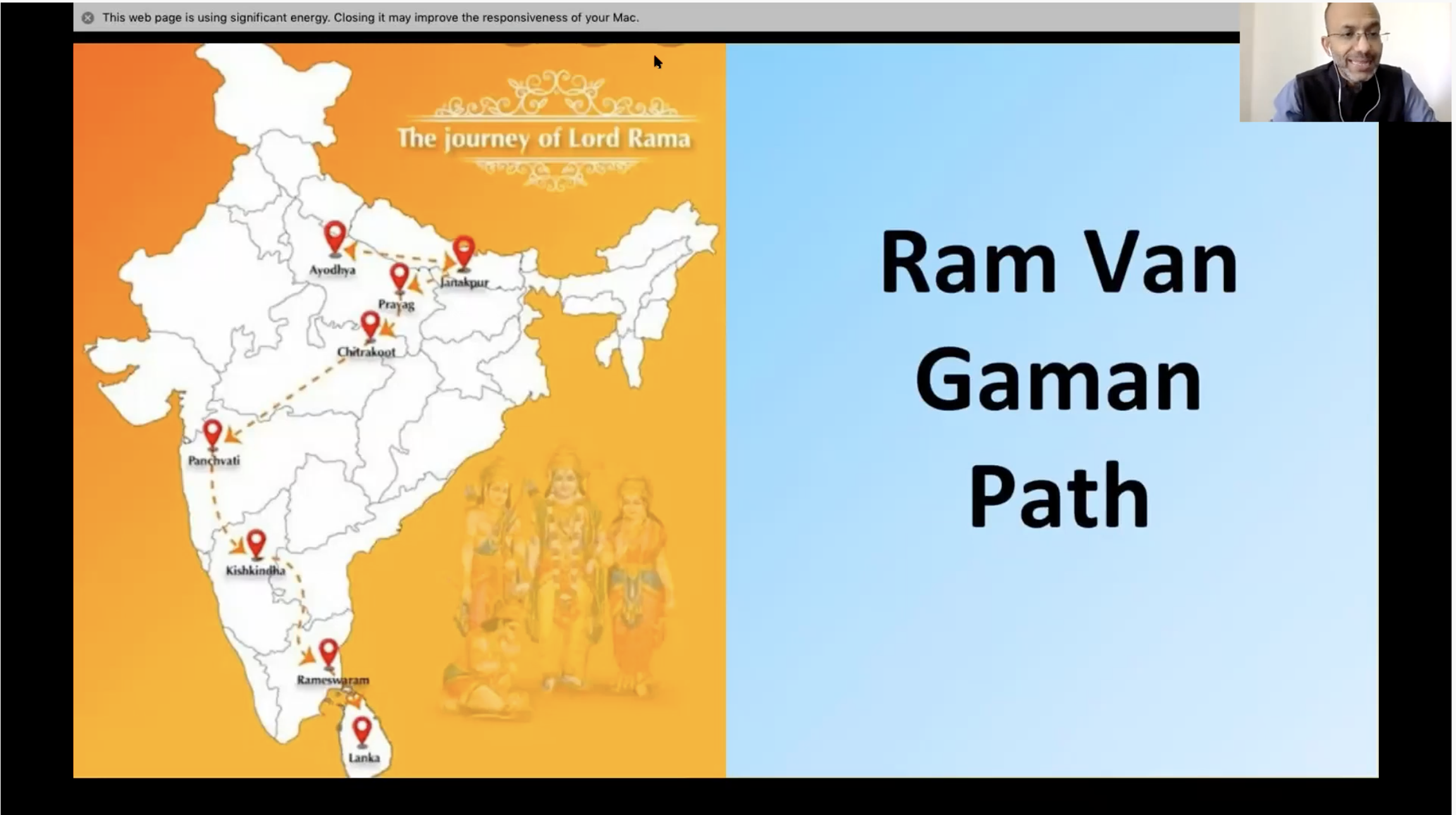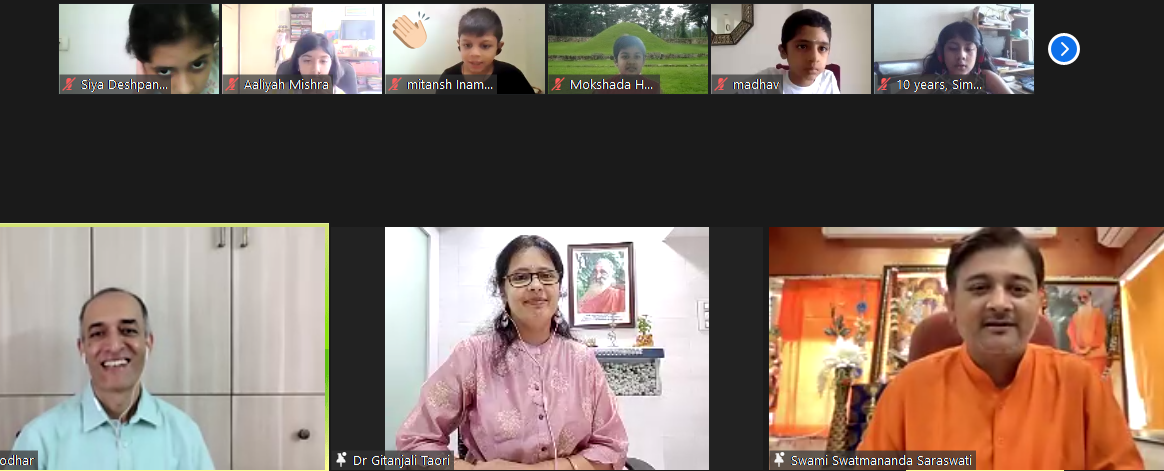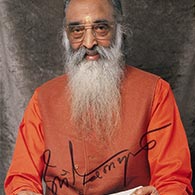DAY 5 - 17th April
Session 1 – Part 1
Life Lessons from Ramayana
by Sri Shantanu Gupta

Sri Shantanu Gupta is an Indian author, a TedX speaker and a political analyst. His latest book, BJP - Past, Present and Future is leading the charts on Amazon. He is the Founder and CEO of the Ramayana School, an initiative to take Sri Rama’s life and Ramayana to schools, colleges and corporates, hold meaningful, value-oriented workshops, reflective exercises and quizzes.
Shantanuji said his talk was to show the historicity of Ramayana and its relevance today. He said that geographically, Ramayana started in Ayodhya, moved on to Madhya Pradesh. Sita-haran happened in Maharashtra and the partnership with Sugreeva and Hanuman in Kishkinda, Karnataka. Hanuman reached Dhanushkodi in Tamil Nadu and finally, Sri Lanka. Shantaniji conducted a quick quiz to test the audience’s knowledge of Ramayana. There are various Ramayanas like Tulsi Ramayan, Kalidas Ramayan and Kamba Ramayana. Even countries outside India have their own Ramayana. Thailand is a Buddhist country, but has its own Ramayana called Rama Kien, which is also their national book. An Islamist country like Indonesia has its own Ramayana called Kakawin Ramayan. The original source is Valmiki Ramayana.
When Vishwamitra rishi left for the forest with Rama and Lakshman, he narrated the story of King Bhagirath of Ikshvaku dynasty, who brought Ganga down from the heavens. Thataka was the first raakshasi that Rama faced. Ram said he could not eliminate Thataka as she was a woman and he was taught not to hurt a woman. Vishwamitra agreed but still told Rama to eliminate Thataka, before she could eliminate them, as she was only in a woman’s body, but was totally devoid of kindness, compassion and motherly love. She killed children, women, men and rishis and destroyed pujas. Hence, she deserved to be killed. When the morality coefficient of Rama got satisfied, only then did he launch his arrow. The lesson is to uphold high moral values, even in crisis. Ramayana is a golden standard of morality. When Dasharath granted Kaikeyi two boons, he said as a king, he must keep his promise. Yatha raja tatha praja. Shantanuji quoted a beautiful chaupaai from Ram Charit Manas - Raghukula reet sadaa chali aayi, praan jaye par vachan na jaayi. Tradition stated that one should not go back on a promise, even if one’s life is at stake.
Shantanuji showed how we have both Rama and Ravana within us and identifying this should be our daily endeavour. Historicity of Ramayana can be proven, as places mentioned in Ramayana exist and invoke a feeling of reverence. There are almost 500 astronomical references in Ramayana and sage Valmiki could not have made up all those star positions. Veda-s and Upanishad-s come under Sruti parampara, while Smriti comprises Itihaasa-s and Purana-s. Shantanuji ended the session with lively Q n A.
Report by
Alka Susheel
Chinmaya Sagar Zone
----------------------------------------------------------------------------------------------------
DAY 5 - 17th April
Session 1 – Part 2
Ramayana in 21st Century
by Sri Yashodeep Deodhar

Sri Yashodeep Deodhar, mechanical engineer, IIT Mumbai, worked in the corporate sector and even started his own company. His inner drive led him to research the original text of Valmiki Ramayana. He has created a unique series of videos named 21 Notes, available on YouTube. Adapting to present times, Deodharji very simply presents Valmiki’s message, quoting directly from the text - Iti ha asa … as it happened.
Ramayana - Fact or Fiction, Was Rama a Person or God, Was Hanuman a Monkey, Was Ravana really bad? - All these questions were answered and much more was clarified by Deodharji, as he presented selections of 21 Notes - short visual episodes that include Sanskrit verses, as written in the epic. Is Ramayana relevant in the 21st century? Yes, it is undoubtedly relevant, as it depicts the ideal behaviour of an ideal man. The stories in their context serve as role models, when the true essence of every situation is deciphered.
Nine to twelve years old children in the audience participated in constructive interaction - Q&A with Deodharji, who patiently answered all queries related to various incidents of Ramayana, clarifying age-old doubts. Enchanting equally to youth and adults, Deodharji’s 21 Notes is indeed an easily accessible, modern-day platform for all spiritual seekers.
Report by
Meenal Roopchand
Chinmaya Sagar Zone
----------------------------------------------------------------------------------------------------------
DAY 5 - 17th April
Session 2
Did Ramayan really Happen? When?
by Sri Nilesh Oak

The involuntary uttering of the name of Rama, when under stress, would have been experienced by many, even the non-devout. Is Rama embedded in our very soul that this utterance springs forth from deep within?
Hence, the nagging question - Was Ramayana just a great narrative by Valmiki, a visionary story-teller, for community motivation or a depiction of what really happened? When one reasons logically, one tends to look for physical evidence, like monuments, corroborated by references from historians, which run in parallel. In Egypt, the pyramids have been traced back to 5000 BC, confirming that the Pharaohs did exist. The narratives of the Pharaohs have been validated. Do we have evidence of this incredible God, Rama and Ramayana? Most relegate this reasonable doubt to be cleared at some later stage in the future.
Sri Nilesh Oak, the Vedanta warrior, has examined the various sources of evidence, hidden in the narrative itself. The answers to logical samshayas are removed by shraddha, to jnana trupti, by application of vignyana buddhi. That Ramayana is a true depiction is sought to be reasonably established by examination of evidence, by fair inferences and then some objective corroboration, by use of Science which we swear by today.
The various references in Ramayana of rivers and seas, which no longer exist today, have been reasonably evidenced by the science of hydrology, which can trace the path of rivers in the past and date the many movements over time. Space photography, which permeates through the surface, evidences the old paths under the earth’s surface, which we cannot see. Astronomy traces back astronomical references in Ramayana to the position of the Pole Star, Agastya, to far south of the Solar System, visible only from the southern tip of India. Astronomy and the mathematical expostulations possible today, with available technology, have also corroborated that the position of the Zodiac and the seasons, as referred to in Ramayana, would have been possible some time in 12,240 BC.
A general description of the earth’s geography and topography described in Ramayana can not only be supplemented by the topography even of today, but corroborated by seismic science, which traces the earth’s movements, of land masses, water bodies, rivers and seas in the past, leading to a reasonably probable state, as described in Ramayana, to about 12000 BC.
Report by Chandrika Vora
Could Valmiki’s imagination have been so very realistic, that it could describe the zodiac, the stars, rivers, seas etc. to this perfection? Or was it most likely, the simple statements of facts as they existed then?
Just as the narratives of Alexander the Great or Socrates or Archimedes are believed by the science of today, as these are associated with some paintings or idols and cross references by many travellers or authors, in many books of the time, so too the Ramayana has been referred to, in many great Indian texts of the past.
On similar grounds, in so many texts or by word carried down, there have been references to the great Rama. The scientific community would also admit and acknowledge that Rama most likely did exist in time, around 12,000 BC. It is for us to contemplate with Shraddha.
Report by
Chandrika Vora
Chinmaya Mahima Zone
-------------------------------------------------------------------------------------------------------


